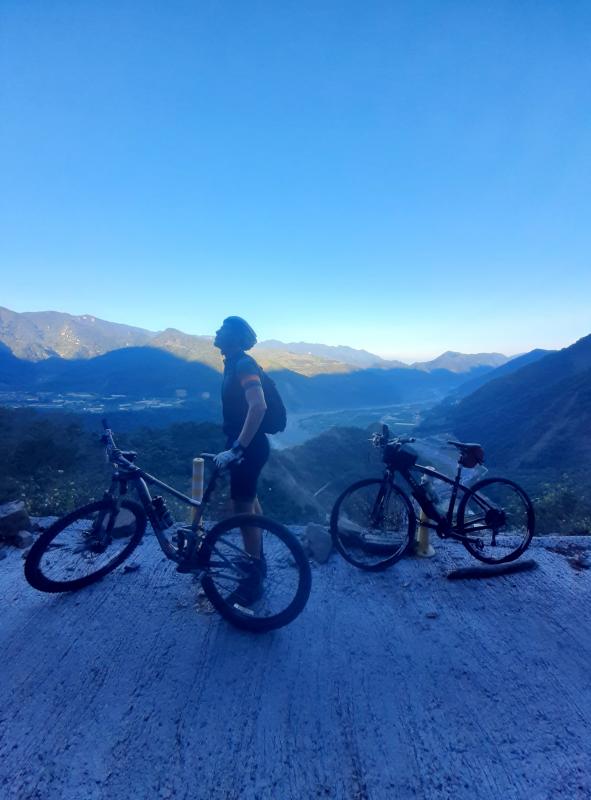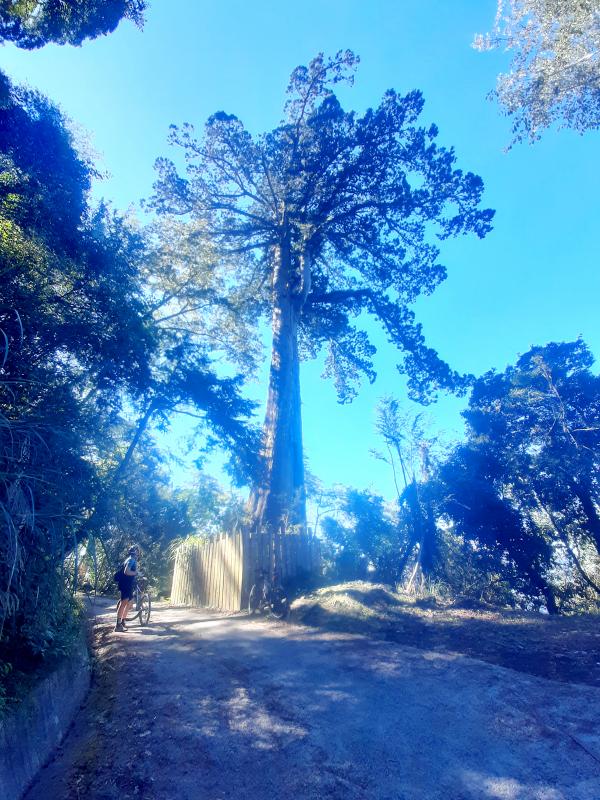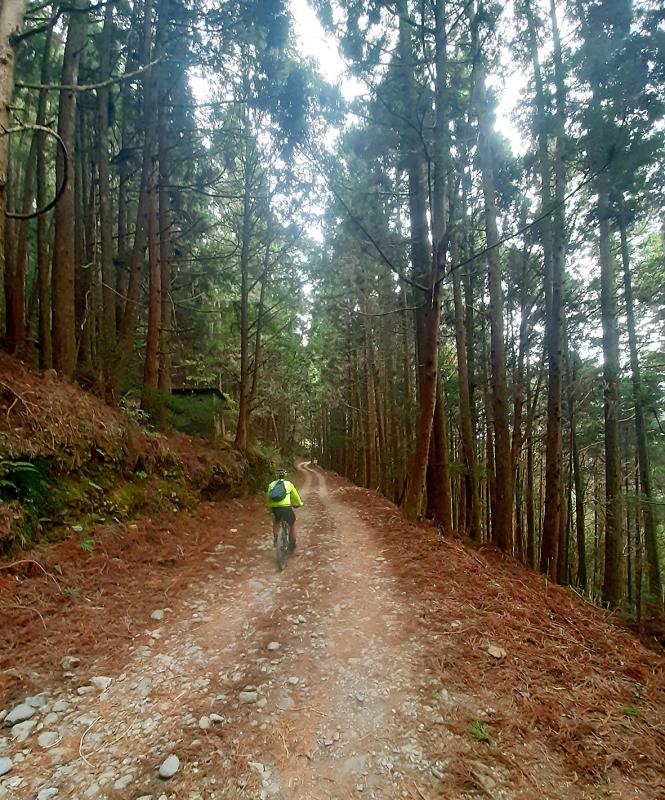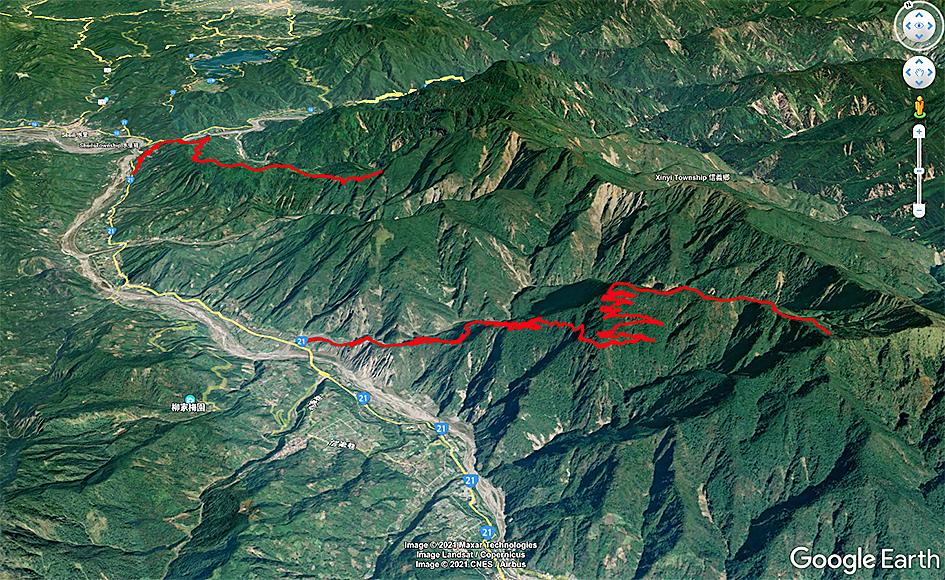There are very few countries in the world where a cyclist can start at sea level in a sub-tropical climate and on the same day ascend to an alpine area. In central Taiwan, Nantou is the only land-locked county and is the most mountainous with access points to the famed “100 Peaks,” or those above 3,000m. As such, it also offers multiple options to get off road on a bicycle.
On a Saturday morning, we leave Kaohsiung by car for the 2.5-hour drive to Renlun Forestry Road (人倫林道), the first and easier of the two routes we’ll ride. Junda Forestry Road (郡大林道), the second and by many degrees more difficult, will take us up to 2,800m in the clouds.
DAY ONE — RENLUN

Photo: Mark Roche
The starting point is at the 80.5km marker on Provincial Highway No 21. (This road is also known as the “New Central Cross-Island Highway”). After parking the car and setting up the bikes the ride started at 9am.
The first 7kms are sealed surface, but after that it becomes concrete and then gravel. This is the kind of surface most likely encountered on tertiary roads that date back to the era of logging during Japanese occupation (1895-1945). The only reason they are still maintained is to offer hikers access to the high mountains.
Starting at an elevation of 400m, the road is steep at the beginning and passes several pig farms — the stench emanating from this area is guaranteed to make progress swift. It took three hours to reach the 17km mark where there is a gate manned by the Forestry Bureau. This is open from 7am to 5pm to allow transport for hikers through. A side gate allows hikers and cyclists to walk through at any time.

Photos: Mark Roche
As we ascend, we pass spectacular coniferous forests. There is something other-worldly about walking or riding over pine needles ascending to a different climate zone. The 17km marker is where cars park for hikers to Siluan Mountain.
I continued past the 17km marker until I come to a major landslide 3km further up the road. This was enough for today since it was just a warm up for the longer and tougher ride planned for tomorrow.
DAY TWO — JUNDA

Photo: Mark Roche
King of the Mountains (KOM) is a term all cyclists are familiar with. In every country there is the highest point that can be accessed by bicycle. In Taiwan, that distinction goes to Wuling (武嶺) on the central cross island highway.
Unknown to me at the time of riding some weeks ago, there is also an off-road KOM, which is the ride up to the 32km marker on the Junda Forestry Road.
To save time, camping at the start of the road at the 94km marker on Provincial Highway No. 21, just 14km east of the Renlun Road makes it practical to cover both over one weekend.

Photo courtesy of Nathan Miller
Straight away, the first 5km is rough concrete, the ascent is dramatic. On most of this road there isn’t enough room for two cars to pass. Starting at 6am on a Sunday, it was surprising how little traffic was passing. As an access point to Junda Mountain (a Top 100 peak) I was expecting lots of 4x4 vans to come along. Optimism was blown out by 7am as more than 20 vans passed. Stop to yield, as this would not be a good place to get into an accident.
One of the best things about this ride is the variation in scenery. In the lower regions the road traces a nearby river, but then it twists and turns deeper into and crossing the lower mountain ranges.
Another bonus was seeing other riders. Some of these had parked part-way up to take the kick out of the climb.
At the 23km marker (2,200m) there is a check-point with a gate that is closed during bad weather and an ancient red cypress that must be at least 1,000 years old. The climb is relentless, so hoping to top out by noon was overly optimistic. It was just after 1pm when I approached the 32km marker at 2,800m.
The ride up was exhilarating and difficult, but there was no time to hang around. There are two reasons why I immediately came back down. First, there is plenty of vehicle traffic on the road returning hikers from their mountain treks. Second, especially in winter, the limited daylight. It was fun and fast, but still took two hours to get back to the gate.
IF YOU GO:
The Renlun Forestry Road is located at the 80.5km marker on Provincial Highway No. 21 at an elevation of 400m. The Junda Forestry Road is located at the 94km marker on Provincial Highway No. 21 at an elevation of 600m. If traveling by train the narrow gauge Jiji line stop at Shuili (水里), would be the closest access point by public transport. There is no permit required for Renlun Forestry Road. However, Junda is within the boundaries of Yushan National Park (玉山國家公園), so a permit is required for both the road and the mountain. You can apply for this online in English (npm.cpami.gov.tw) from the National Park headquarters or apply in person at Sinyi main police station. Both roads are prone to landslides and it’s no adviseable to ride in bad weather. The roads are quite busy in the mornings and aftnernoons and it’s always a safer to slow down and stop to let vehicular traffic pass.

In the March 9 edition of the Taipei Times a piece by Ninon Godefroy ran with the headine “The quiet, gentle rhythm of Taiwan.” It started with the line “Taiwan is a small, humble place. There is no Eiffel Tower, no pyramids — no singular attraction that draws the world’s attention.” I laughed out loud at that. This was out of no disrespect for the author or the piece, which made some interesting analogies and good points about how both Din Tai Fung’s and Taiwan Semiconductor Manufacturing Co’s (TSMC, 台積電) meticulous attention to detail and quality are not quite up to

April 21 to April 27 Hsieh Er’s (謝娥) political fortunes were rising fast after she got out of jail and joined the Chinese Nationalist Party (KMT) in December 1945. Not only did she hold key positions in various committees, she was elected the only woman on the Taipei City Council and headed to Nanjing in 1946 as the sole Taiwanese female representative to the National Constituent Assembly. With the support of first lady Soong May-ling (宋美齡), she started the Taipei Women’s Association and Taiwan Provincial Women’s Association, where she

It is one of the more remarkable facts of Taiwan history that it was never occupied or claimed by any of the numerous kingdoms of southern China — Han or otherwise — that lay just across the water from it. None of their brilliant ministers ever discovered that Taiwan was a “core interest” of the state whose annexation was “inevitable.” As Paul Kua notes in an excellent monograph laying out how the Portuguese gave Taiwan the name “Formosa,” the first Europeans to express an interest in occupying Taiwan were the Spanish. Tonio Andrade in his seminal work, How Taiwan Became Chinese,

Mongolian influencer Anudari Daarya looks effortlessly glamorous and carefree in her social media posts — but the classically trained pianist’s road to acceptance as a transgender artist has been anything but easy. She is one of a growing number of Mongolian LGBTQ youth challenging stereotypes and fighting for acceptance through media representation in the socially conservative country. LGBTQ Mongolians often hide their identities from their employers and colleagues for fear of discrimination, with a survey by the non-profit LGBT Centre Mongolia showing that only 20 percent of people felt comfortable coming out at work. Daarya, 25, said she has faced discrimination since she